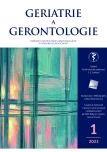Recommendations for screening and risk stratification of falls in the elderly in the light of the new ”World guidelines for falls prevention and management for older adults“
Authors:
Topinková Eva
Authors‘ workplace:
Geriatrická klinika 1. LF UK a VFN Praha
Published in:
Geriatrie a Gerontologie 2023, 12, č. 1: 12-17
Category:
Overview
Falls and fall-related injuries are common in old age and negatively influence functional independence and quality of life. There is sufficient scientific evidence on falls-associated negative outcomes – morbidity, mortality and increased societal costs. Despite many awareness campaigns and health programmes targeted at decreased risks and incidence of falls there is no evidence confirming decreased of falls in developed countries in the last decade.
In the article we overview the recommendations including their GRADE classification for the screening and stratification of fall risk in view of the recent ”World guidelines for falls prevention and management for older adults: a global initiative“ (2022) aimed at health professional based on scientific evidence and expert consensus. Part of the recommendations is a new fall risk algorithm. It enables to stratify patients into 3 risk groups (low, intermediate, and high fall risk) with specific recommendations for further assessment and for individualized intervention programs. Risk stratification thus represents the first step for successful management of patients which – if implemented – is expected to decrease the incidence of falls and their negative health and high resource-consuming outcomes.
Keywords:
Falls – older age – fall-related injury – stratification of fall risk – falls prevention and management – world global guidelines
Sources
1. James SL, Lucchesi LR, Bisignano C, et al. The global burden of falls: global, regional and national estimates of morbidity and mortality from the global burden of disease study 2017. Inj Prev 2020; 26: 3–11.
2. Haagsma JA, Olij BF, Majdan M, et al. Falls in older aged adults in 22 European countries: incidence, mortality and burden of disease from 1990 to 2017. Inj Prev 2020; 26: 67–74.
3. National Instiute for Health and Care Excellence (NICE). Surveillance of Falls in Older People: Assessing Risk and Prevention (NICE Guideline CG161). London: National Instiute for Health and Care Excellence, 2019.
4. Montero-Odasso MM, Kamkar N, Pieruccini-Faria F, et al. Evaluation of clinical practice guidelines on fall prevention and management for older adults: a systematic review. JAMA Netw Open 2021; 4(12): e2138911.
5. Montero-Odasso M, van der Velde N, Martin FC, et al. World guidelines for falls prevention and management for older adults: A global initiative. Age Ageing 2022; 51(9): afac205.
6. Fougere BMJ, Arai H, Bauer JM, et al. Precision medicine: the future management of geriatric conditions. J Nutr Health Aging 2018.
7. Burns ER, Lee R, Hodge SE, et al. Validation and comparison of falls creening tools for predicting future falls among older adults. Arch Gerontol Geriatr 2022.
8. Tinetti ME, Speechley M, Ginter SF. Risk factors for falls among elderly persons living in the community. N Engl J Med 1988; 319: 1701–1707.
9. Jepsen B, Robinson K, Ogliari G, et al. Predicting falls in older adults: an umbrella review of instruments assessing fait, balance, and functional mobility. BMC Geriatr 2022; 22.
10. Ganz DA, Latham NK. Prevention of falls in community-dwelling older adults. N Engl J Med 2020; 382: 734–743.
11. Berková M, Topinková E, Mádlová P, et al. Krátká baterie pro testování fyzické zdatnosti seniorů. Vnitř Lék 2013; 59 (4): 256–263.
12. Topinková E. Mobilita jako klíčový faktor zdravého stárnutí. Geri a gero 2021; 10(1): 15–22.
13. Haines TP, Hill K, Walsh W, et al. Design-related bias in hospital fall risk screening tool predictive accuracy evaluations: systematic review and meta-analysis. J Gerontol A Biol Sci Med Sci 2007; 62(6): 664–672.
14. Morris ME, Haines T, Hill AM, et al. Divesting from a Scored Hospital Fall Risk Assessment Tool (FRAT): A cluster randomized non-inferiority trial. J Am Geriatr Soc 2021; 69(9): 2598–604.
15. Jellett J, Williams C, Clayton D, et al. Falls risk score removal does not impact inpatient falls: A stepped-wedge, cluster-randomised trial. J Clin Nurs 2020; 29(23–24): 4505–4513.
16. Cameron ID, Dyer SM, Panagoda CE, et al. Interventions for preventing falls in older people in care facilities and hospitals. Cochrane Database Syst Rev 2018; 9: CD005465.
17. Nunan S, Brown Wilson C, Henwood T, et al. Fall risk assessment tools for use among older adults in long-term care settings: A systematic review of the literature. Australas J Ageing 2018; 37(1): 23–33.
18. Vlaeyen E, Poels J, Colemonts U, et al. Predicting falls in nursing homes: A prospective multicenter cohort study comparing fall history, staff clinical judgment, the care home falls screen, and the fall risk classification algorithm. J Am Med Dir Assoc 2021; 22(2): 380–387.
Labels
Geriatrics General practitioner for adults Orthopaedic prostheticsArticle was published in
Geriatrics and Gerontology

2023 Issue 1
- Metamizole vs. Tramadol in Postoperative Analgesia
- Memantine in Dementia Therapy – Current Findings and Possible Future Applications
- Memantine Eases Daily Life for Patients and Caregivers
- Metamizole at a Glance and in Practice – Effective Non-Opioid Analgesic for All Ages
- Advances in the Treatment of Myasthenia Gravis on the Horizon
Most read in this issue
- Frailty evaluation in a geriatric patient. Clinical guidelines of the Board of the Czech Society of Gerontology and Geriatrics
- Is melatonin a suitable hypnotic for the elderly?
- Hypopituitarism misdiagnosed as stroke
- Recommendations for screening and risk stratification of falls in the elderly in the light of the new ”World guidelines for falls prevention and management for older adults“
